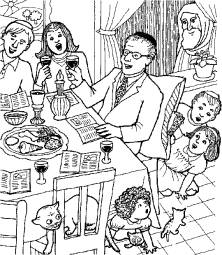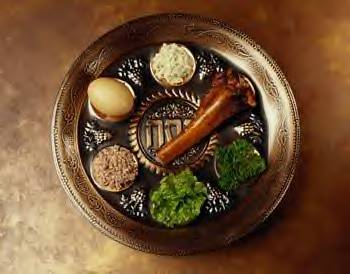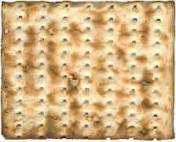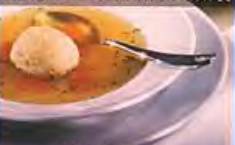LITR 4333: American
Immigrant Literature

Student Poetry Presentation 2003
Reader: Giselle Hewitt
Respondent: Chris Ornelos
“Preparations for Seder”
By Michael Glaser
Unsettling America, p. 176
About the Author: Michael Glaser has taught at St. Mary's since 1970. His teaching aims to explore both literature and writing as a means of being actively engaged in the life of the mind and the life of the spirit. Glaser founded and directs the annual Literary Festival at St. Mary's.
Presentation:
Seder (Sa’ der) – the feast of Passover
Pesach is defined as "z'man heyruteinu," the season of our freedom.
Passover marks the miracle of redemption from slavery in Egypt. Shavuot commemorates the covenant with G-d that was defined when the Ten Commandments were received at Mount Sinai. Omer (the days between Passover and Shavuot), marks the move from the day of freedom to the day of when the purpose of that freedom was unveiled.
In an attempt to include every type of Jew many types of seders have been created. There are feminist seders; peace seders with Arab-Americans and with African-Americans; interfaith seders with Christian groups; gay and lesbian seders and seders for vegetarians. Seders like these have special potential to highlight parallels between the Passover story and modern struggles for justice and liberation from various forms of oppression. Regardless of what Jewish group is in attendance and what common interests they share, each one centers around a version of the Haggadah, the book of tales and blessings that guides the seder.
The Haggadah is split into two parts, from the beginning of the seder until the meal which is eaten in the middle of the Haggadah the seder is about past redemption, such as the Exodus, and from the meal to the end it looks to future redemption. Many modern Jews have included the stories of redemption from the inquisition, pogroms, and the Holocaust.
It is taught that in every generation one is to view themselves as though they had actually gone from Egypt with their ancestors. Egypt, which is "Mitzraim" in Hebrew stems from the root "tzar," which means narrow or constrained. In order to leave Egypt, each individual must break out of their personal narrowness, freeing themselves to achieve full spiritual potential.
Four cups of wine or juice is drank in the course of the seder. Which symbolize the four phrases used by God in promising to free the Jews from bondage: "I will bring you out," "I will rescue you," "I will redeem you," "I will take you (to be my people)." (Exodus 6:6-7)
As the 10 plagues that G-d sent against the Egyptians are recited, a drop of wine from your cup is removed to decrease the joy and to symbolize the suffering that occurred by those harmed in the process of liberation. (Egyptian animals being killed by hail, and Egyptian firstborns dying)

The seder is supposed to take place with everyone in a reclining position. This is because slaves were forced to eat in a hurry while the free were able to recline during meals. It is said that on erev Pesach (the eve of Passover), rich and poor are indistinguishable and all are free and thus privileged to recline. Many families have the tradition of placing pillows on each chair.
Definitions:

Seder Plate
Five
items are traditionally placed on a round Seder plate:
The shank bone symbolizes the "strong hand and outstretched arm" with which G-d redeemed the Israelites from bondage and of the lambs sacrificed for the blood to be put over the doorpost so the Hebrew houses would be “passed over”
The roasted egg symbolizes fertility.
The bitter herb (often horseradish) symbolizes the bitterness of slavery.
The parsley is a symbol of spring and rebirth.
The charoset (a mixture of apples, nuts and wine) symbolizes the mortar with which the ancestors in Egypt laid bricks for Pharaoh.

Matzah
Traditional Judaism interprets hametz (leavened bread) as a metaphor for the "yetzer ha-rah" -- man's evil inclination. Matzah is a flat unleavened bread Jews eat during Passover. It is also seen as a link between exile and redemption. It is the bread of affliction, eaten by slaves who did not have decent food. It is also a symbol of freedom, because when the Jews left Egypt they rushed away with unleavened bread.

Matzah Ball Soup
Chicken broth soup with carrots and round dumplings made from matzah meal.
Schmaltz is Yiddish (a German/Hebrew language) for rendered or melted fat (German Jewish tradition).
Objectives:
Literary objective 2b- return to homeland in a way of reaching stage 5
Stage 5 – Rediscovery or reassertion of ethnic identity
Cultural objective 1b: National migration – migration of an entire people
Interpretation: This poem is about a Jewish American family celebrating the Passover seder. The narrator appears to be third generation. As noted by a student in a previous poetry presentation “[The] Seder ritual is like visiting the homeland. It connects the participants to the ancestors and even to the original homeland, the Promised Land of the Jews.”
In the second stanza the poet remembering his grandmother refers to how “much harder” it must have been for her to prepare the seder since the chickens were so much leaner, and in the third stanza he shows how even though “the fat is plentiful [now]” it is hard to carry on the tradition. But he knows that he must “not forsake the traditions of [his] ancestors” no matter how hard it is.
In the third stanza he prepares the traditional schmaltz for matzah ball soup, feeds the "cracklings" to himself and his children, while realizing the deadly contrast between the ancient Hebrew vision of freedom in the Promised Land as "succulent and dangerous" as the matzah balls made with the carcinogenic fat of animals. In spite of these dangers he must continue tradition, even if he has to reinvent the traditions in order to pass them on to his children.
In the fourth stanza the poet shows how his ancestors in search of “freedom” went through danger and not knowing what the future held for them. He suggests the same for the modern Jews – that they also reach out and “want more” – the journey is not “complete”.
Questions: During the seder an extra cup of wine is left on the table for Elijah and a child at one point is sent to open the door for the prophet who is to be a sign of messianic times. Do you think that the line “redemption is not yet complete” from the Haggadah, and the poet’s line at the very end “wanting more” is referring to this idea of Elijah?
Do you think the Grandmother who lived in Boston was a first generation immigrant, if so when he speaks of the “chickens that ran free in the yards” is he referring to the old world or her home in Boston?